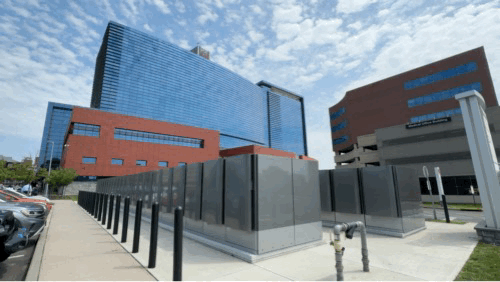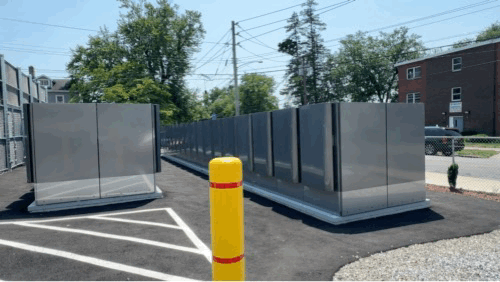By Han Ji-myung, Reporter, July 25, 2024, 06:01
Stamford Hospital with 2.7MW and Bridgeport Hospital with 3.05MW Hospitals Highlight "Stable Power Supply and Cost Savings"
[Editor’s Note] Targeting cumulative overseas construction orders worth $1 trillion this year, the overseas construction sector aims to turn the tide after a prolonged economic downturn exacerbated by COVID-19. However, competition in the overseas order market is intensifying. News1 re-examines the dynamic sites of K-construction, which navigates fierce international landscapes armed with advanced construction technology and accumulated expertise.

(New York, USA) - "There are residential areas across the street, yet we've never received any noise complaints. The installation process and operation have been smooth, and the system is resilient even against natural disasters like hurricanes."
At Stamford Hospital in Connecticut, visited on the 17th for a fuel cell power plant interview, 62 refrigerator-sized units stood on 3,332 square feet site. Contrary to expectations of a building packed with wires, pipes, and equipment, these neatly designed modules are Solid Oxide Fuel Cell (SOFC) power plants.
The design isn't just sleek. Despite being a power plant, it is quieter than an air conditioner outdoor unit. Conversations could easily be held nearby, and there have never been any complaints from the adjacent residential area about noise.
Fuel cells produce electricity through the electrochemical reaction of hydrogen and oxygen, making them eco-friendly power generation facilities. They play a crucial role in ensuring the stable operation of essential facilities like data centers, hospitals, and financial systems, where power outages can cause significant economic and social harm.
SK ecoplant Americas, the North American subsidiary of SK ecoplant, collaborates with Bloom Energy to provide fuel cell-based power solutions to essential facilities, supporting their continuous and stable operation. Fuel cells are particularly valued as the only distributed power source capable of meeting the growing urban power demand.

◇ Stamford Hospital "Self-Sufficiency of 36% Power Through Fuel Cells"
Stamford Hospital's SOFC power plant, with units SMH000 (2.0MW) and SMH001 (0.7MW), supplies 36% of the hospital's total power, playing a central role in its operations.
Edward Oldak, Director of Facilities Management at Stamford Health, stated, "Previously, we relied 100% on the local power company. However, since implementing fuel cells, we can now meet over 30% of our power demand independently."
Explaining the decision to install fuel cells, Oldak said, "The ability to provide a stable power supply to the community, reduce costs, and secure reliable power that we manage ourselves was highly attractive."
He also emphasized the economic benefits of fuel cells. "Fuel cells are crucial for us," Oldak said. "By reducing our electricity costs by about 10%, we've been able to invest the savings into cancer research, new technology development, and expanding medical services and technologies needed by the community, significantly aiding disease treatment and patient recovery."
The daily power production here totals 62MWh, enough to power approximately 6,200 households, considering an average daily household consumption of 10kWh.

◇ Bridgeport Hospital "Eco-Friendly and Economical Power Supply"
A 30-minute drive from Stamford Hospital leads to Bridgeport Hospital, which also features a fuel cell facility. Unlike coal or nuclear power plants, fuel cell power plants can be installed close to power consumption areas, with this facility located in a corner of the hospital parking lot. It produces 69.5MWh of power daily.
Peter Romano, Director of Facilities Management at Bridgeport Hospital, said, "We receive 60% of the hospital's total power from the fuel cell facility, saving about $25,000 (approximately 30 million KRW) monthly."
Romano cited cost savings and environmental protection as the main reasons for adopting fuel cells. "The significant cost savings from using fuel cells help us maintain a balanced budget," he said.
He added, "The economic benefits are not the only advantage. Fuel cells are efficient in operation, scalable as needed, have a clean appearance, and produce minimal noise, making them suitable for residential areas."
Romano continued, "One of the main advantages of fuel cells is their minimal mechanical moving parts, requiring little maintenance while providing immediate power. Compared to alternatives like cogeneration plants or solar power plants, fuel cells occupy less space and are much easier to maintain."
An SK ecoplant Americas official stated, "The fuel cell installations at the two hospitals are expected to save $1.9 million annually, amounting to $19 million over 10 years."
For more details, please refer to the original article

Comments